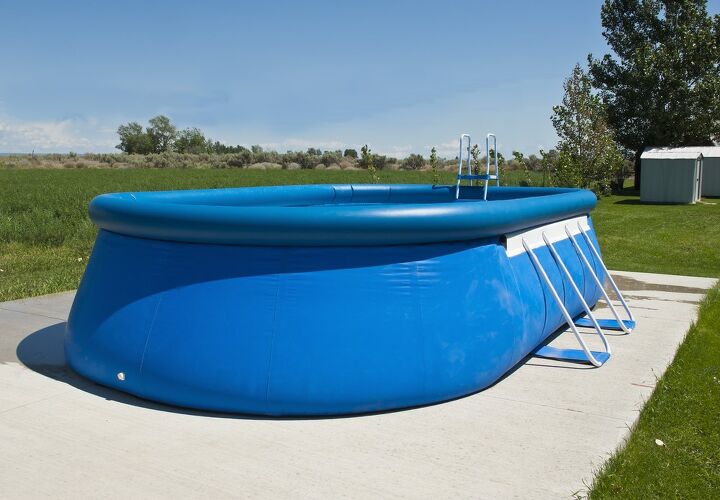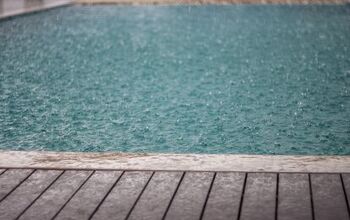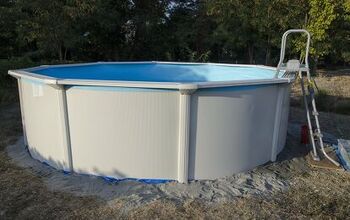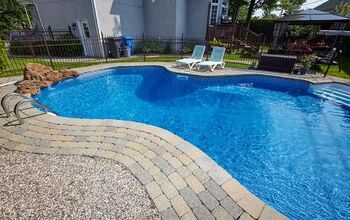Can You Put An Above Ground Pool On Concrete? (Find Out Now!)

Above ground pools are one of the most popular add-ons for backyards, and it doesn’t take an Einstein to figure out why. Pools rule! And above ground pools are the most affordable type. Traditionally, these are put on a grassy part of your backyard ontop of sand. But, what if you want to put it on something like concrete?
You can install an above-ground pool on concrete without too much of a problem. However, you need to make sure that you use urethane foam pads to ensure the bottom of your pool stays safe. Ensuring that your pool is level is also paramount to pool safety.
Let’s talk a little bit more about what you should know before you put an above ground pool on a concrete floor. It’s good to know before you consider this an option.
Do You a Need Pool, Spa, or Hot Tub Contractor?
Get free, zero-commitment quotes from pro contractors near you.

Is It Possible To Put An Above Ground Pool On Concrete?
It absolutely is possible to place an above-ground pool on concrete. Unfortunately, it is not the best potential option. Grass with a sand topping is a lot more accommodating and cushioned. Concrete has the tendency of snagging on pool liners, which makes it less than ideal. This is particularly worrisome if you have an Intex pool.
Is It Safe To Put An Above Ground Pool On Concrete?
Yes, as long as proper precautions are made. Your pool shouldn’t pop just because it’s on concrete. However, you have to make sure that your pool is the right type, that the concrete is level, and that you have the right padding underneath. Preparation and ensuring you have the right type of pool is key here!
What Type Of Above-Ground Pool Can Go On Concrete?
If you have a rectangular above-ground pool, then you’re out of luck. Rectangular pools do not do well on concrete floors. They are too rigid and often get stressed by the tough terrain. This leads to leaks in the corners of the pool. Circular pools are generally the best choice, followed by oval pools.
When in doubt, ask a pool salesman if they would suggest putting said pool on concrete. Some models simply cannot handle it.
How To Put An Above Ground Pool On Concrete
Now that we’ve gone through the warnings, it’s time to get to the juicy part of the article. Let’s discuss how to put an above ground pool on concrete.
- Check to make sure that your concrete slab is level. You can usually use a level for this. Of course, if you need help determining the level of your concrete, you can try the same tricks that are used to determine the level of regular soil.
- Next, lay out a firm urethane mat. Assuming that your concrete is level, it’s time to lay out a urethane mat. This will help grip the bottom of the pool and also protect the pool lining from scratches. Concrete is rough. Urethane is tough enough to withstand it and also protect the lining ontop from the grittiness of the concrete.
- Then, install the pool over the mat. Each pool has its own way of being installed. With Intex pools, it’s generally just a matter of adding water. With circular pools that have piping or a cage, you may need to take a look at their individual instructions.
Note: If you want to place an oval pool on your concrete flooring, do not try to assemble it yourself. Oval pool builds can still get stressed due to the uneven force on each of the walls. Professional installation can help reduce the chance of a pool collapse, which is why it’s important to go to the pros for oval pools.
How Much Of An Incline Can You Have On An Above-Ground Pool On Concrete?
The less of an incline you have on your pool, the better off you are. With pools placed on concrete, the maximum incline you can allow for your slab is lower than what it’d be for a pool. Concrete is simply harder than pools, which means that the pool doesn’t have as much of a chance to adjust itself.
Because of the added rigidity that concrete offers, the incline on your concrete slab cannot be larger than 1 inch maximum. Any more than that, and you will start to see a heightened risk of pool collapse and injury. Always make sure that your concrete is level both longitudinally and latitudinally before you add that pool!
Do You a Need Pool, Spa, or Hot Tub Contractor?
Get free, zero-commitment quotes from pro contractors near you.

Related Questions
Can you use sand to help house an above-ground pool on concrete?
Neither sand nor soil are good for placing an above-ground pool on concrete. While they may seem like sturdy options, the truth is that they have a massive propensity for washing away from the base. This will leave a massive mound of sand in the center, while the edges of the pool lose support.Even if it seems sturdy enough, you should avoid this at all costs. This is an easy way to make sure that avoid having a pool collapse on your hands.
Why should you avoid placing a rectangular pool on concrete?
Rectangular pools tend to require additional cushioning and softness around the edges of their liner. Concrete is too hard and encourages a high level of tension in parts of the pool that are prone to leakage. While you could technically place a solid rectangular pool on concrete, the truth is it’s just not wise.These types of pools (or really any with uneven sides or corners) will have a shorter lifespan if they are placed on concrete. It’s sad but it’s true.
How long should an above ground pool last?
An above ground pool is not going to last as long as your typical in-ground pool would. But, it still lasts quite a long time. A typical above-ground pool can last between seven to 15 years. If you pick a pool that comes from a trusted brand and maintain it very well, the most you can stretch its lifespan to would be approximately 20 years.
Related Guide

Ossiana Tepfenhart is an expert writer, focusing on interior design and general home tips. Writing is her life, and it's what she does best. Her interests include art and real estate investments.
More by Ossiana Tepfenhart



























